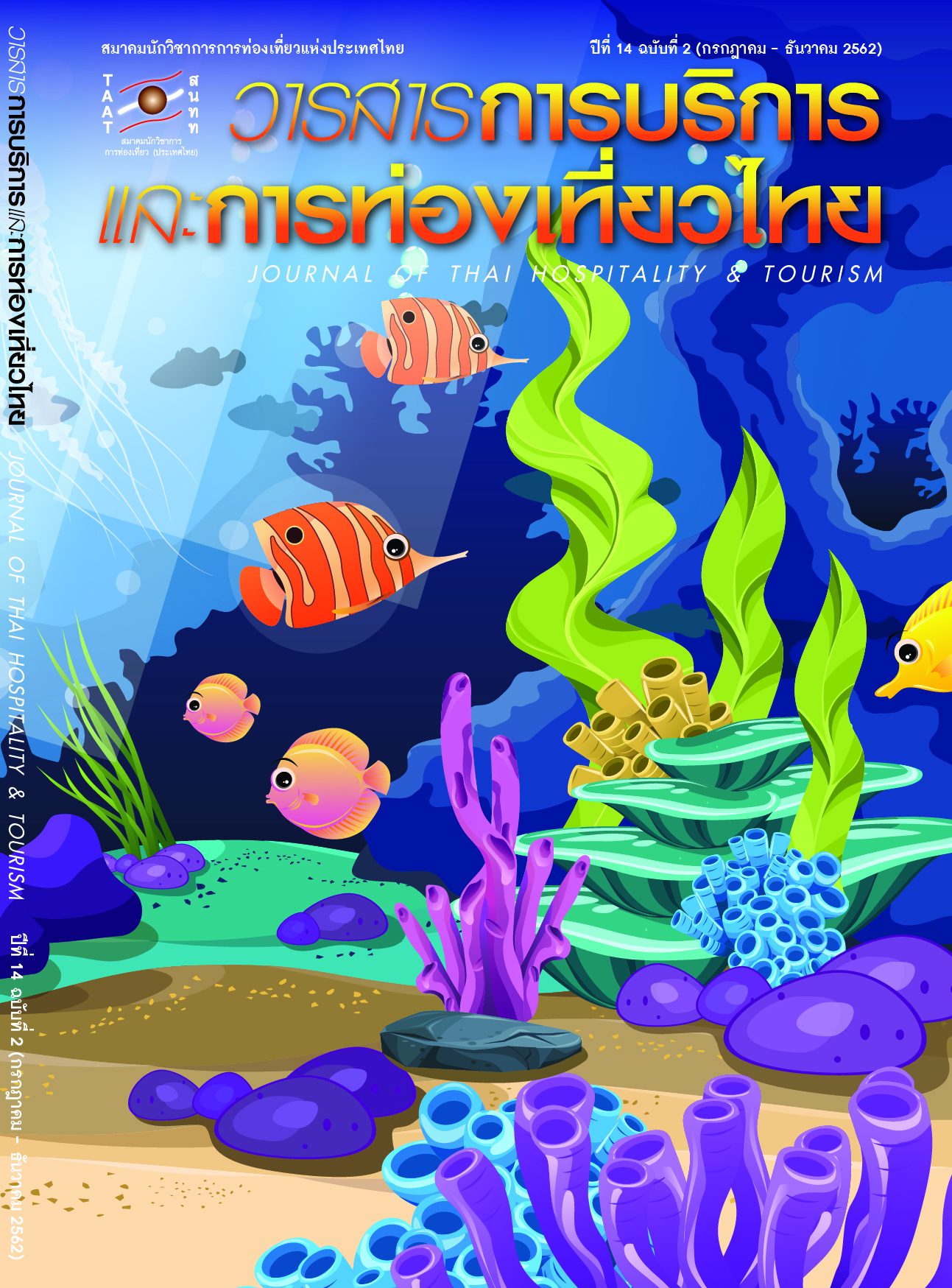แนวทางการพัฒนาเอกลักษณ์และการรับรู้ภาพลักษณ์แบรนด์ประเทศไทย ด้านการท่องเที่ยวเชิงสุขภาพและความงาม
Main Article Content
บทคัดย่อ
การวิจัยนี้มีวัตถุประสงค์หลักเพื่อนำเสนอแนวทางการพัฒนาเอกลักษณ์แบรนด์ประเทศไทยในมิติด้านการท่องเที่ยวเชิงสุขภาพและความงาม เพื่อให้ทราบถึง (1) เอกลักษณ์แบรนด์ประเทศไทยในฐานะผู้ส่งสาร (2) การรับรู้ภาพลักษณ์แบรนด์ประเทศไทยของนักท่องเที่ยวชาวต่างชาติในฐานะผู้รับสาร และนำมาซึ่งคำตอบ (3) เพื่อนำเสนอแนวทางการพัฒนาเอกลักษณ์แบรนด์ประเทศไทยด้านการท่องเที่ยวเชิงสุขภาพและความงาม ดำเนินการวิจัยโดยใช้วิธีแบบผสมผสาน ทั้งวิจัยเชิงคุณภาพ คือการสัมภาษณ์เชิงลึกภาครัฐและภาคเอกชนจำนวน 11 คน และเชิงปริมาณคือการใช้แบบสอบถามซึ่งได้คำตอบจากนักท่องเที่ยวชาวจีน (Chinese Tourists) 400 คน และชาวสหราชอาณาจักร (The United of Kingdom: UK Tourists) 400 คน รวมเป็น 800 คน ความสำคัญของเอกลักษณ์แบรนด์ประเทศไทยที่ค้นพบเกี่ยวข้องกับทั้งการวางตำแหน่งของแบรนด์ (Brand Positioning) และการมีบุคลิกภาพของแบรนด์ (Brand Personality) ที่ชัดเจนเกี่ยวกับผู้รักสุขภาพ โดยผู้รับบริการจะได้รับความสุขทั้งร่างกายและจิตใจ ผลสรุปการวิจัยพบเกี่ยวกับแบรนด์ประเทศไทย คือ เอกลักษณ์แบรนด์ไทยมีคุณค่าซึ่งเป็นลักษณะที่จับต้องได้และจับต้องไม่ได้ ด้านการท่องเที่ยวเชิงสุขภาพและความงามของไทย ประกอบด้วย (1) คนไทย (Thai people) ที่มีจิตใจและมีความเป็นมืออาชีพในการบริการ (2) วัฒนธรรม (Culture) ซึ่งประเทศไทยมีความเป็นวิถีไทย (Thainess) ลักษณะบุคลิกภาพของคนในประเทศ (3) การดึงดูดด้านการลงทุนจากต่างชาติ (Investment) ซึ่งประเทศไทยมีความพร้อมทั้งจากการสนับสนุนจากภาครัฐและความพร้อมของภาคเอกชน (4) รัฐบาล (Governance) รัฐบาลไทยมีนโยบายให้การสนับสนุนด้านการท่องเที่ยวเชิงสุขภาพและความงามอย่างเต็มที่ (5) การส่งออก (Export) ประเทศไทยมีการส่งออกทั้งคนและสินค้าโดยมีต้นกำเนิดมาจากประเทศไทย (Country of origin) และ (6) การท่องเที่ยว (Tourism) ถือเป็นข้อที่โดดเด่นของประเทศไทย ซึ่งประเทศไทยมีความหลากหลายทั้งเรื่องทรัพยากรธรรมชาติแหล่งท่องเที่ยวและการบริการด้านสุขภาพและความงาม
Article Details
เอกสารอ้างอิง
[2] Anholt, S. (2007). Competitive Identity: the New Brand Management for Nation, Cities, and Regions. Palgrave Macmillan, United Kingdom.
[3] Anholt, S. (2017). Nations as Brands: Why Global Perception Matters. Retrieved April 30, 2017, from https://blog.gfk.com/2017/02/nation-as-brands-why-global-perception-matters.
[4] Chareonwongsak, Kriengsak. (2017). Nation Branding. Retrieved May 1, 2017, from https://www.kriengsak.com/nation-branding
[5] Department of Service Support. (2017). Policy Development of the Country Strategy in Medical Hub 2017 – 2026. Ministry of Health.
[6] Ministry of Tourism and Sports. (2016). Tourism Economic Review No.3 (January – March 2016). Retrieved from https://www.mots.go.th/ewt_dl_link.php?nid=7622.
[7] Office of the Permanent Secretary. (2017). The Second Tourism Development Plan 2017 – 2021. Ministry of Tourism and Sports.
[8] Supparerkchaisakul, Numchai. (n.d.). Factor Analysis. Retrieved June 30, 2017, from https://www.priv.nrct.go.th/ewt_dl.php?nid=696
[9] Suwannaket, Thanthip. (2016). The Important of Nation Branding. Retrieved May 17, 2017, from https://www.tdri.or.th
[10] Taesarin, Borworn. (n.d.). New Economy Model for Thailand 4.0. Retrieved May 12, 2017, from https://www.sobkroo.com/articledetail.asp?nid=150.
[11] Yamane, T. (1976). Statistics: An Introductory Analysis. Retrieved June 30, 2017, from https://hpe4.anamai.moph.go.th/surveillance/data/yamane.pdf


